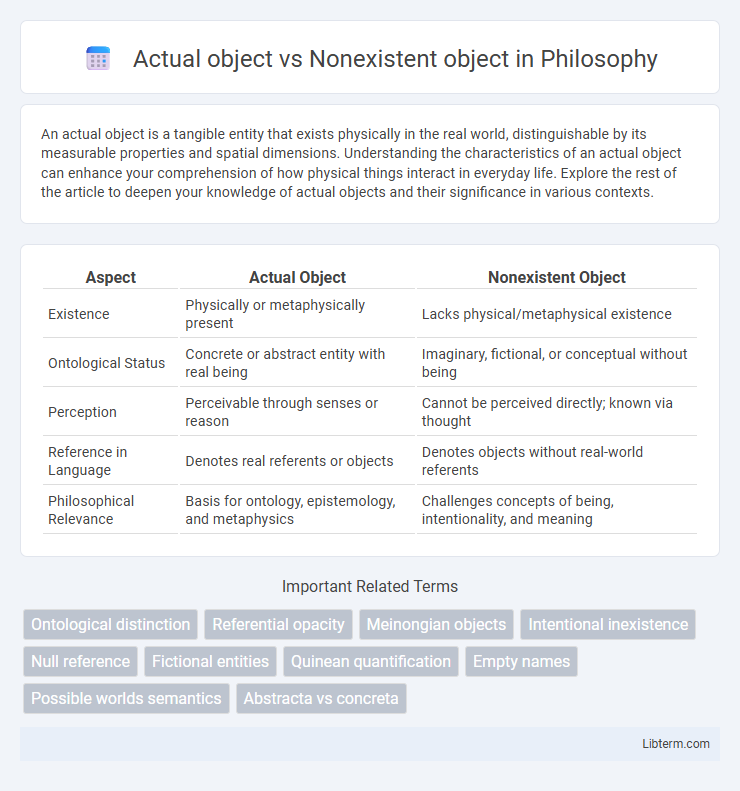An actual object is a tangible entity that exists physically in the real world, distinguishable by its measurable properties and spatial dimensions. Understanding the characteristics of an actual object can enhance your comprehension of how physical things interact in everyday life. Explore the rest of the article to deepen your knowledge of actual objects and their significance in various contexts.
Table of Comparison
| Aspect | Actual Object | Nonexistent Object |
|---|---|---|
| Existence | Physically or metaphysically present | Lacks physical/metaphysical existence |
| Ontological Status | Concrete or abstract entity with real being | Imaginary, fictional, or conceptual without being |
| Perception | Perceivable through senses or reason | Cannot be perceived directly; known via thought |
| Reference in Language | Denotes real referents or objects | Denotes objects without real-world referents |
| Philosophical Relevance | Basis for ontology, epistemology, and metaphysics | Challenges concepts of being, intentionality, and meaning |
Understanding Actual Objects: Definition and Examples
Actual objects exist independently in reality and have concrete properties, such as a tree, a chair, or a person. These objects can be perceived, measured, and interacted with, making them fundamental to everyday experience and empirical study. Understanding actual objects involves recognizing their tangibility and presence in the physical world, distinguishing them clearly from abstract concepts or nonexistent entities.
Defining Nonexistent Objects in Philosophy
Defining nonexistent objects in philosophy involves analyzing entities that have no actual existence but are still referenced in language and thought, such as fictional characters or hypothetical concepts. Philosophers like Alexius Meinong distinguish nonexistent objects from actual objects by assigning them properties without asserting their existence, using theories like Meinongian Object Theory or modal realism. This approach allows for meaningful discourse about things that cannot be empirically verified, enriching ontology and metaphysics by bridging linguistic reference and ontological status.
Key Differences: Actual Objects vs Nonexistent Objects
Actual objects possess physical presence and can be perceived through sensory experience, enabling interaction within the real world. Nonexistent objects are purely conceptual or imaginary entities that lack physical form, existing only within thought, language, or fiction. The key difference lies in ontological status: actual objects have tangible reality, whereas nonexistent objects hold epistemological significance without empirical existence.
Ontological Status: What Exists and What Does Not
Actual objects possess ontological status as entities that exist in reality with tangible properties and can be empirically verified through observation or interaction. Nonexistent objects, such as fictional characters or hypothetical constructs, lack physical presence and cannot be detected or measured, yet they hold ontological significance within mental or conceptual frameworks. The distinction between actual and nonexistent objects informs metaphysical discussions on existence, emphasizing the criteria for what qualifies as 'real' versus 'imaginary' in philosophical ontology.
Historical Perspectives on Nonexistent Objects
Historical perspectives on nonexistent objects trace back to medieval philosophers like Alexius Meinong, who argued for the ontological status of objects that do not exist but have properties, such as fictional characters or hypothetical entities. Later developments in analytic philosophy, particularly in the 20th century, refined the distinction between actual objects that exist in reality and nonexistent objects understood as intentional objects of thought or reference. These debates have pivotal implications for the philosophy of language, metaphysics, and cognitive science, influencing theories of intentionality and meaning.
Actual Objects in Everyday Experience
Actual objects in everyday experience include tangible entities such as furniture, tools, and living beings that occupy physical space and can be perceived through the senses. These objects have definitive properties and exist independently of thought or perception, allowing for interaction and practical use. The consistent presence and materiality of actual objects distinguish them from nonexistent objects, which lack physical manifestation despite being conceptually imaginable.
Nonexistent Objects in Fiction and Imagination
Nonexistent objects in fiction and imagination are entities that lack physical presence but exist cognitively through narrative and conceptual frameworks. These objects, such as fictional characters or mythical creatures, are studied in metaphysics and philosophy of language to understand reference, intentionality, and the ontological status of imaginary entities. The ability to discuss and attribute properties to nonexistent objects highlights the complexity of human cognition and linguistic structures in representing non-actual realities.
The Role of Language in Referring to Nonexistent Objects
Language plays a crucial role in allowing speakers to refer to nonexistent objects by using definite descriptions, fictional names, and empty terms, enabling communication about entities that lack actual existence. Semantic theories such as Meinongianism and Russellian analysis explore how meaning is constructed for nonexistent objects through linguistic structures, distinguishing between reference and sense. This ability to linguistically represent nonexistent objects supports cognitive functions like imagination, counterfactual reasoning, and myth-making, demonstrating language's power to extend beyond tangible reality.
Philosophical Theories Addressing Nonexistent Entities
Philosophical theories addressing nonexistent entities often distinguish between actual objects, which possess concrete existence, and nonexistent objects, which are objects of thought without real-world referents; theories such as Meinongianism assert that nonexistent objects have a form of being or subsistence despite lacking physical existence. Alternatively, the existentialist and ontological perspectives, including those influenced by Frege and Russell, argue that nonexistent objects have no ontological status but can be meaningfully discussed through linguistic or logical frameworks. Modal realism and possible world semantics also contribute by treating nonexistent entities as existing in alternate or possible worlds, thus providing a rigorous approach to understanding their conceptual role.
Implications of the Actual vs Nonexistent Objects Debate
The debate between actual objects and nonexistent objects centers on the ontological status and implications for truth conditions in semantics and metaphysics. Actual objects possess a concrete existence in reality, grounding reference and truth in empirical verification, whereas nonexistent objects challenge traditional ontology by allowing discourse about entities that lack physical instantiation yet influence meaning and intentionality. This distinction impacts fields like philosophy of language and logic by forcing reevaluation of notions such as existence, reference, and predication in theories of meaning and knowledge representation.
Actual object Infographic

 libterm.com
libterm.com